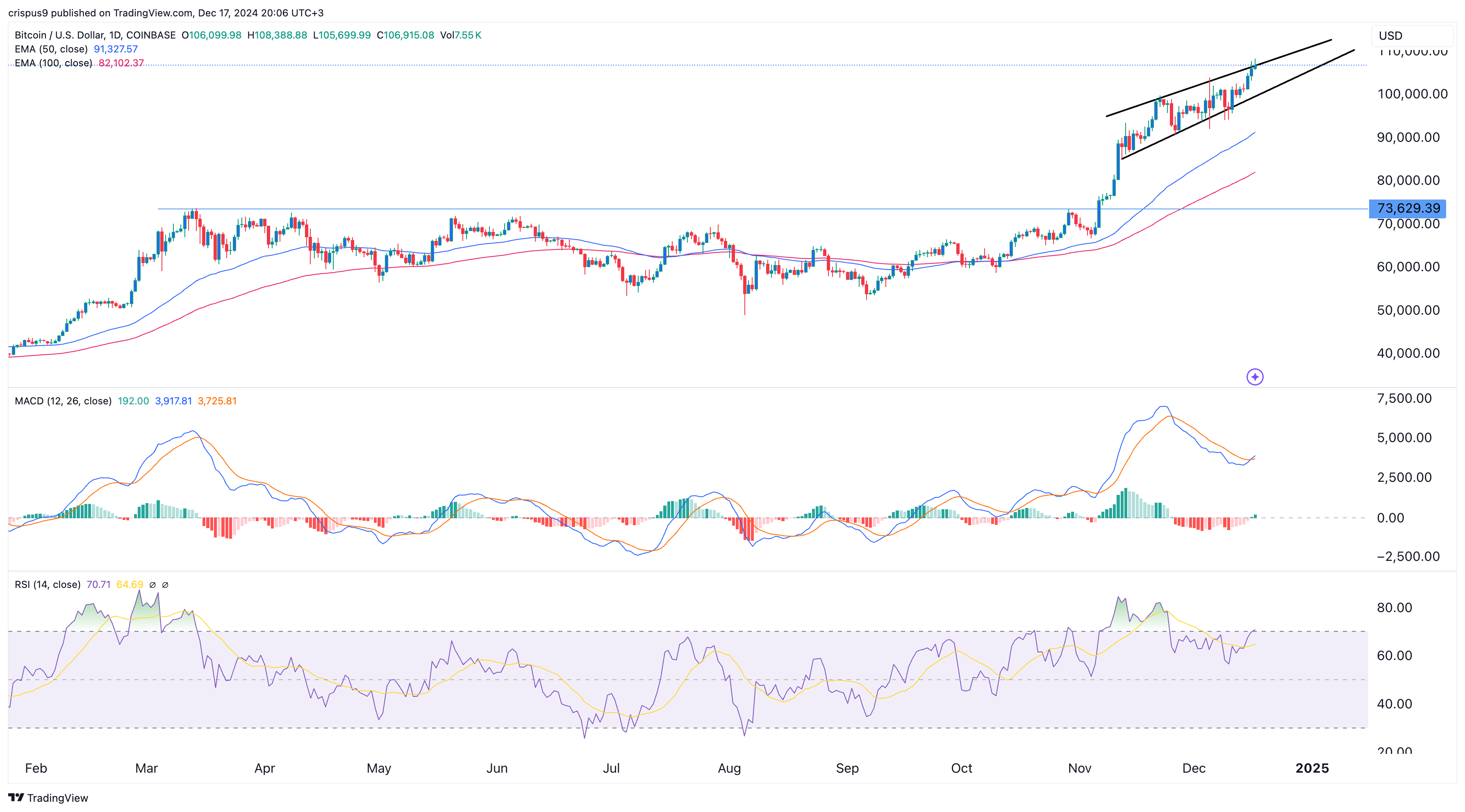Bitcoin price rallied to a record high of $108,000 on Dec. 17, continuing a bull run that began in 2023.
Bitcoin (BTC) has surged by nearly 150% this year, driven by rising demand and decreasing supply growth. The unwinding of high interest rates by the Federal Reserve and other central banks has also contributed to this upward momentum.
Data from SoSoValue shows that spot Bitcoin ETFs have accumulated over $36 billion in assets, bringing their combined total to more than $120 billion. This growth indicates that Bitcoin is increasingly competing with gold for investor attention.
People asking me about this. Answer is YES, if you include all bitcoin ETFs (spot, futures, levered) they have $130b vs $128b for gold ETFs. That said, if you just look at spot, btc is $120b vs $125b for gold. Either way, unreal we even discussing them being this close at 11mo. https://t.co/hq8QAc14Xa
— Eric Balchunas (@EricBalchunas) December 17, 2024
Bitcoin supply growth has not been strong as mining difficulty has jumped. Data by CoinGlass shows that the amount of Bitcoin remaining in exchanges has continued to fall this year.
These supply and demand dynamics will likely push Bitcoin prices higher in the long term. This demand will likely come from governments and corporations, which have seen Microstrategy move from a tiny company into a $90 billion firm.
The next key catalyst that could have an impact on Bitcoin is the Federal Reserve decision on Wednesday. Economists expect that the bank will cut rates by 0.25%, bringing the year-to-date cuts to 1%.
Bitcoin and other risky assets do well when the Fed is cutting rates because investors often move from low-yielding money market funds.
The Fed may, therefore, disrupt the Bitcoin price surge by having a hawkish tone because of the sticky inflation. Its main concern is that Donald Trump’s policies of deportation, tax cuts, and tariffs will stir inflation.
Data released last week showed that inflation is still a big challenge as the headline Consumer Price Index rose to 2.7%. Core CPI, which excludes the volatile food and energy price, remained at 2.2%. As such, while the Fed will likely cut rates this week, it might deliver a hawkish outlook.
Bitcoin price analysis

The daily chart shows that BTC has maintained a strong bullish trend over the past few weeks. The price remains above all major moving averages, signaling that bulls are still in control. Additionally, BTC has formed a cup and handle pattern, pointing to more gains.
However, the chart also reveals a rising wedge pattern, a common reversal signal. The MACD and Relative Strength Index have both formed bearish divergence patterns.
As a result, there is a possibility of a brief pullback, potentially to $103,000, following the Federal Reserve’s interest rate decision on Wednesday.
Bitcoin price rallied to a record high of $108,000 on Dec. 17, continuing a bull run that began in 2023.
Bitcoin (BTC) has surged by nearly 150% this year, driven by rising demand and decreasing supply growth. The unwinding of high interest rates by the Federal Reserve and other central banks has also contributed to this upward momentum.
Data from SoSoValue shows that spot Bitcoin ETFs have accumulated over $36 billion in assets, bringing their combined total to more than $120 billion. This growth indicates that Bitcoin is increasingly competing with gold for investor attention.
People asking me about this. Answer is YES, if you include all bitcoin ETFs (spot, futures, levered) they have $130b vs $128b for gold ETFs. That said, if you just look at spot, btc is $120b vs $125b for gold. Either way, unreal we even discussing them being this close at 11mo. https://t.co/hq8QAc14Xa
— Eric Balchunas (@EricBalchunas) December 17, 2024
Bitcoin supply growth has not been strong as mining difficulty has jumped. Data by CoinGlass shows that the amount of Bitcoin remaining in exchanges has continued to fall this year.
These supply and demand dynamics will likely push Bitcoin prices higher in the long term. This demand will likely come from governments and corporations, which have seen Microstrategy move from a tiny company into a $90 billion firm.
The next key catalyst that could have an impact on Bitcoin is the Federal Reserve decision on Wednesday. Economists expect that the bank will cut rates by 0.25%, bringing the year-to-date cuts to 1%.
Bitcoin and other risky assets do well when the Fed is cutting rates because investors often move from low-yielding money market funds.
The Fed may, therefore, disrupt the Bitcoin price surge by having a hawkish tone because of the sticky inflation. Its main concern is that Donald Trump’s policies of deportation, tax cuts, and tariffs will stir inflation.
Data released last week showed that inflation is still a big challenge as the headline Consumer Price Index rose to 2.7%. Core CPI, which excludes the volatile food and energy price, remained at 2.2%. As such, while the Fed will likely cut rates this week, it might deliver a hawkish outlook.
Bitcoin price analysis

The daily chart shows that BTC has maintained a strong bullish trend over the past few weeks. The price remains above all major moving averages, signaling that bulls are still in control. Additionally, BTC has formed a cup and handle pattern, pointing to more gains.
However, the chart also reveals a rising wedge pattern, a common reversal signal. The MACD and Relative Strength Index have both formed bearish divergence patterns.
As a result, there is a possibility of a brief pullback, potentially to $103,000, following the Federal Reserve’s interest rate decision on Wednesday.





